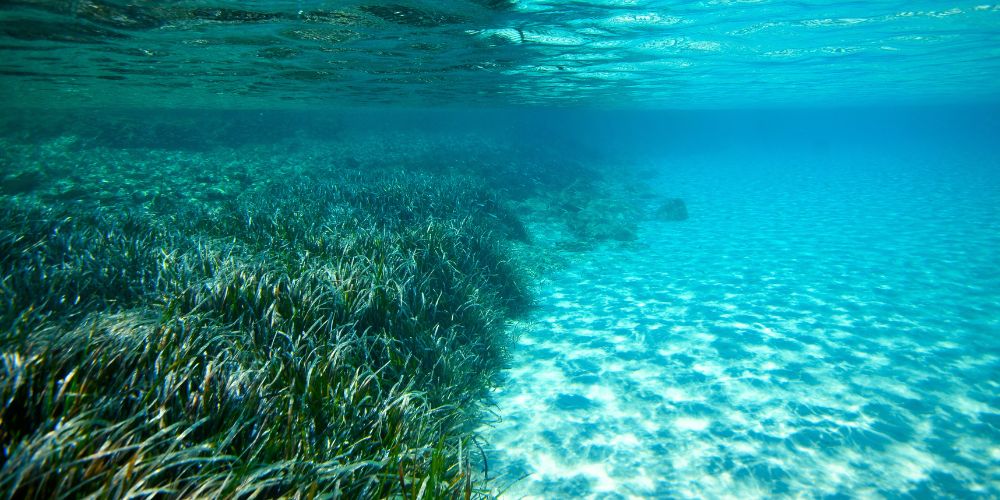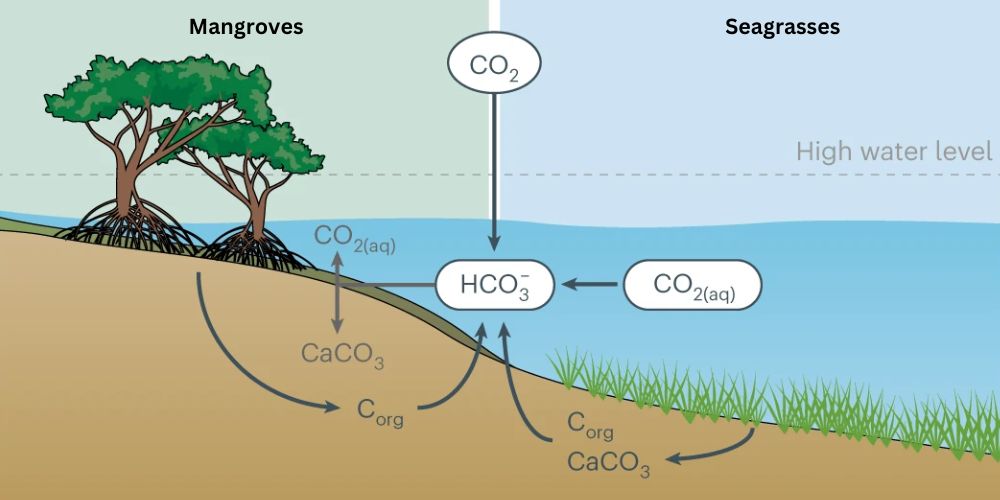
Mangroves and Seagrasses: Key Players in Carbon Sequestration
Posted by Enrico Gennari on November 22, 2024
Carbon sequestration is the capture and long-term storage of atmospheric CO₂.
Carbon sequestration is the capture and long-term storage of atmospheric CO₂. While terrestrial forests are among the most well-known carbon sinks, marine ecosystems such as mangroves, seagrasses, and salt marshes also serve as vital "blue carbon" sinks, capturing and storing large amounts of carbon in coastal and marine environments.
Mangroves, seagrasses, and salt marshes, which have extensive carbon stores and high sequestration rates, are often overlooked in climate discussions. These blue carbon ecosystems not only play an important role in storing carbon but also support biodiversity and protect coastlines, highlighting their importance in climate change mitigation.
Ecological Role of Mangroves and Seagrasses
Mangroves and seagrasses are essential components of marine ecosystems, each contributing uniquely to overall ocean health. Together, they provide functions that maintain biodiversity, improve water quality, and protect coastal communities. Mangroves stabilize shorelines against erosion, offer protection from storm surges, and enhance water quality through nutrient and sediment filtration. They also create essential nursery habitats for many marine species with their characteristic complex root structures.
Similarly, seagrasses contribute to marine ecosystem health by maintaining water quality, stabilizing sediment, and serving as a critical nursery for commercially important species. They are also key food sources for herbivores, including manatees, sea turtles, and even bonnethead sharks.
Carbon Storage Capacity of Mangroves and Seagrasses
Mangroves can store carbon within their trunks, leaves, and in the soil. Some studies estimate that mangroves can sequester around 1,000 metric tons of carbon per hectare. To put that into perspective, that’s roughly equivalent to the weight of 140 elephants or 50 fully loaded school buses spread across a rugby field. The amount of carbon stored in mangroves and seagrasses is enormous and can remain trapped for thousands of years, making them one of the most effective carbon sinks on the planet.
Seagrasses also play a significant role in blue carbon storage. These underwater meadows can store up to 83,000 metric tons of carbon per square kilometer, trapping organic material and sediment in their roots and storing carbon on the ocean floor. This dual mechanism—carbon captured in biomass and trapped in sediments—helps create extensive reservoirs known as "carbon stocks."
How Mangroves and Seagrasses Sequester Carbon

Source: nature.com
It is believed mangroves store carbon through the entrapment of organic matter in their root systems. This prevents the organic matter from decomposing and releasing CO2 into the atmosphere. The waterlogged, low-oxygen soils of mangrove forests have significantly slow decomposition rates, allowing organic matter to accumulate and store carbon over millennia, creating highly efficient carbon sinks.
Similar to those in mangroves, seagrasses capture carbon through photosynthesis and bury it within sediments. Their extensive root systems trap fine particles and organic matter, which then accumulate under layers of sediment, effectively storing carbon long-term and forming substantial carbon stocks.
Threats to Mangroves and Seagrasses
Despite their benefits, mangroves and seagrasses are increasingly threatened by human activities, including deforestation, coastal development, pollution, and climate change.
Deforestation and Coastal Development
Mangrove forests are often cleared for agriculture, aquaculture, and urban development. This habitat loss not only releases stored carbon into the atmosphere but also prevents future carbon sequestration. According to the Global Mangrove Alliance, deforestation of mangroves releases approximately 0.02 gigatons of carbon per year. To put that into perspective, that’s the same as the annual emissions of about 4.3 million cars or the carbon emitted by burning around 5 billion gallons of gasoline. This contributes significantly to global carbon emissions.
Seagrass meadows face similar threats from coastal development, dredging, and damage from boat propellers, which all reduce their carbon storage capacity. Pollution, especially nutrient runoff from agriculture and wastewater, can cause harmful algal blooms that block sunlight, creating low-oxygen conditions that not only inhibit seagrass growth but can also lead to seagrass die-offs.
Pollution and Climatic Change
Pollution from oil spills, chemical runoff, and plastic debris degrades these ecosystems and diminishes their role as carbon sinks. Climate change further exacerbates these threats by increasing sea levels and warming water temperatures. Rising sea levels and higher temperatures can lead to the degradation of both mangrove forests and seagrass meadows, accelerating carbon release into the atmosphere and contributing to global warming.
Habitat Loss and Its Contribution to Carbon Emissions
The destruction of mangroves and seagrasses has a direct impact on carbon emissions. As these ecosystems degrade, the carbon stored in biomass and soil is released into the atmosphere, increasing CO₂ levels and reducing the planet’s ability to absorb future emissions. Mangrove loss, for example, contributes an estimated 10% of global deforestation emissions, despite mangroves covering only 0.7% of the tropical forest area. Similarly, the degradation of seagrass meadows has been linked to releases of up to 299 metric tons of carbon per hectare. To put that into perspective, that’s roughly equivalent to the emissions from burning 3.5 million gallons of gasoline, or the carbon produced by about 620 cars over the course of a year.
Successful Conservation Initiatives
Numerous successful conservation and restoration initiatives have been implemented to protect and restore mangroves and seagrasses, demonstrating the potential of these blue carbon ecosystems to contribute to climate change mitigation.
In Indonesia, which has vast mangrove forests, initiatives like "Mangrove for the Future" have replanted thousands of hectares since 2006, restoring carbon sequestration capacities and advancing coastal protection. Seagrass restoration efforts, such as the "Posidonia Project" in the Mediterranean, have worked to replant the native seagrass species, Posidonia oceanica, increasing carbon storage and improving marine biodiversity.
The Blue Carbon Initiative
The Blue Carbon Initiative is a global program that supports the protection and restoration of blue carbon ecosystems by promoting sustainable management practices and involving local communities. Through these collaborative efforts, the initiative highlights the crucial role of blue carbon in combating climate change.
Conclusion
Mangroves and seagrasses are among the most effective natural defenses against climate change, offering unparalleled carbon storage capabilities and essential ecological benefits. They protect coastlines, support biodiversity, and enhance water quality, making their conservation vital for environmental and human well-being. Addressing the threats they face through restoration and preservation is crucial for a sustainable future.